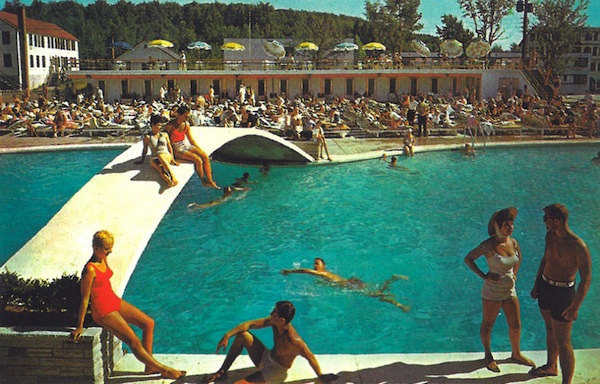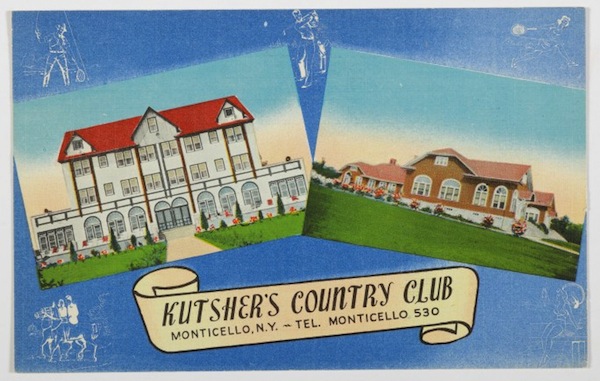A postcard of the legendary Kutsher’s resort.
After the Lower Eastside of Manhattan, there is perhaps no place that holds so enormous a place in the imagination of Jewish life in North America as the Catskills.
The Catskill Mountains, really a region of the larger Appalachian Mountain range, is a sprawling section of southeastern New York state. Just 160 kilometres from New York City, the area is a world away from the workaday life that lower- and middle-income Jews of mid-century America experienced. The relative proximity to the world’s largest Jewish population centre made the Catskills a destination for generations of Jewish (and other) Americans.
Phil Brown, a professor at Northeastern University, author of Catskill Culture: A Mountain Rat’s Memories of the Great Jewish Resort Area and founder of the Catskills Institute, delivered a webinar March 3. It was presented by the Jewish Study Centre.
The resort region emerged, to use an inapt metaphor, by farmers trying to create a silk purse from a sow’s ear. The land was not good for farming. Chickens and dairy cows were about all it would sustain, and farmers began opening their homes to temporary lodgers.
“You didn’t come to a hotel, you didn’t come to a resort, you came to our house,” Brown reflected. “You came to our family and they treated you like family. And it didn’t matter if you wanted another potato because we grew them here, we grew the corn, we made the cheese, we made our own butter and the cows were giving us milk twice a day. We could make all the butter and cream and sour cream that you needed…. It was served with a full hand because that’s what people came up here for.”
Elaborate menus were an invitation to excess. “So many things to choose from,” said Brown, “and it wasn’t like you chose one or two of these things for breakfast, you had one from each group. You had the fruit, you had the appetizer, then the cereal, then the eggs and the pancakes.”
In addition to the three meals a day the all-inclusive resorts offered, there was a concession to buy snacks while lounging by the pool or playing tennis, then noshes during the evening program at the “casino” – this wasn’t a gambling den, just the name most resorts gave to the theatre space – and, after that, maybe a drive into town for a bite at one of the late-night diners.
In an astonishing array of about 500 “resorts” – ranging across every quality – and another 500 or so “bungalow colonies,” there was something for everybody. One colony, with accommodations that were a cross between cabins and tents, attracted single young people and newlyweds.

In many cases, families would come for the entire summer – two months for a manageable price. Mom and kids might stay all through, with fathers commuting back to the city on Sundays. At its heyday, the Jewish Catskills drew 500,000 visitors a year, making it, in the 1950s and ’60s, the world’s largest resort area.
The glossy catalogues produced by the local tourism agency had subtle and less-subtle code words to segregate their clientele. “Dietary laws observed” was the signal for a Jewish resort, while “Churches nearby” sent the opposite message. The phrase “No Hebrews” left less to the imagination.
Brown’s own family story is a microcosm of Jewish American strivers taking entrepreneurial risks in the Catskills hospitality industry. “My parents began in 1946 as the owners of a small hotel called Brown’s Hotel Royal on White Lake,” he said. “They had that hotel until 1952. Not very long – six years.”
Economic challenge was a part of the Catskills experience in part because of extended families and the porous boundaries between work and play in vacationland. “It was a place where the family came to work, the family came to stay and no one could tell the difference if they were working or staying,” he said. “And this is partly why my parents went broke. People thought they would have a job there and they didn’t really do much work.”
After losing their hotel to bankruptcy, they worked for others. “My mother, always a chef, my father having other jobs, running a concession, working as a maître d’, working as a chauffeur,” Brown said. Young Phil started working in the resorts at a early age. By definition, the places that employed them were the smaller ones; the larger, swanky resorts only hired male chefs.
“After they lost their hotel in 1952, they moved down to Fort Pierce, a little town 150 miles or so north of Miami,” he said. “The idea here is that they would get a new start here and that all of the Jews coming down to go to Miami Beach would be so hungry for good New York food by the time they got to Florida that they would stop in here on the way.”
Opening a restaurant with a large sign declaring “Brown’s Jewish Restaurant” in a community where the Ku Klux Klan was still openly marching took chutzpah. They crossed local norms when an African-American family walked in and was served like any customers would be. But it was not racism or antisemitism that did the business in. “My parents, having lost a hotel because they were good businesspeople, did not do well running restaurants,” he said wryly.
They found their way to Miami Beach and they ran the coffee shop at the Haddon Hall Hotel, which was partly owned by the Kutsher family, who owned one of the Catskill’s most renowned resorts. It was not uncommon that proprietors of Catskills hotels would also own properties in Florida, capturing clientele for the summer season as well as the winter.
The resorts were not just getaways but miniature societies, where people knew lots about each other and created very intimate relationships. This was at least partly because the folks one would run into there were not usually strangers.
The Seven Gables Hotel, where Brown really learned the hotel industry ropes, was known as a “Jackson Heights hotel,” because most of the people who worked and lived there came from the Jackson Heights area of the New York borough of Queens. The owners came from there, they hired staff from there and they recruited guests via the local synagogues and social networks.
There was a huge diversity in the properties, but, generally, he said, lower-cost bungalow colonies had cabins with their own kitchens, so the food was prepared by the family rather than eating in a restaurant or dining hall. These were often built on a lake or river and so did not have swimming pools. Nor did they provide a wealth of entertainment. The bungalow colonies supplemented the low rent by selling groceries to the guests.
On the flip side, the higher-end hotels and resorts not only served multi-course meals, they also imported vaudeville acts from Manhattan’s Second Avenue theatres and other comedians, musicians and entertainers, who would work a circuit in the “Borscht Belt,” often making a good living and building a name for themselves.
By the 1970s, the Catskills were starting to decline as a destination. Some of the old resorts have become yeshivot or Jewish kids camps. Some are being used as boarding houses. Many of the smaller and mid-sized places have been converted into private homes. At least one is now a resort for Korean-Americans and another has been revived by Russian-speaking Jews. But the heyday is well and truly gone, Brown said.
“It’s a world mostly lost to us physically,” he said, “yet so powerful in our memories and emotions.”

